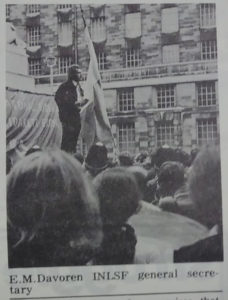
On 12 January the Zimbabwe Solidarity Action Committee and the Black People’s Alliance called for a protest at Rhodesia House, London, against apartheid. The protest saw conflict with the police when protestors tried to storm the South African Embassy in Trafalgar Square, resulting in 31 people being arrested.
Among them Ed Davoren, who was then Convenor of the London branch of the Revolutionary Socialist Student Federation, and a leading figure in the Revolutionary Marxist-Leninist League. Both organisations were at the forefront of Maoist organisations at the time around student politics and the Vietnam War (for more detail see 1968 – Protest and Special Branch part 1: Overview and political groups of 1966-1969 on this site).
A contemporary report recounts that Davoren was snatched from the group of protestors, bloodying his face and provoking the crowd in the process.[1]Black and White Unite and Fight!, Freedom News, vol.30, no.2, 18 January 1969. He was hospitalised and subsequently placed in Brixton Prison.
Seven of those arrested went to trial in November 1969, all acquitted bar Davoren and another. They were convicted of assault of two policemen and received six month suspended sentences.[2]Left’s court victory, ”Socialist Worker”, 20 November 1969.
Evidence provided by police in the trial is in the National Archives, of which a selection is presented here – namely that material which came from Special Branch officers. A number of officers are of particular interest as they were involved in the targeting of other left-wing protest as well.
One is Det. Sgt. John Wilson who is thought to be the same as John “Jock” Wilson who became head of Special Branch in the 1970s were he was noted for his role in policing Irish terrorism.[3]Commander John Wilson, The Telegraph, 27 February 2006 (accessed 24 July 2019).
Det. Ch. Insp. Elwyn Jones is another significant figure. He had lead the September 1968 raid on the Black Dwarf newspaper, and later that same year in the investigation into the publication of the ‘Softly Softly’ article by that publication.
The cross-examination of him in the Davoren trial contains the following somewhat curious exchange:
This is one of the earliest known references to this particular role of Special Branch as countering ‘extremism’ [4]Peter Salmon, Domestic Extremism, Powerbase.info, 2015 (accessed 24 July 2019). The effort to distinguish from subversion is also interesting in the context that counter-subversion had been the purview of MI5 since 1931, [5]Christopher Andrew, In Defense of the Realm: The authorised history of MI5, Penguin, 2009; also cited at MI5’s official website, MI5.gov.uk: see The Inter-War Years and The Threat of Subversion. and speaks to the perception of the lawfulness of the work of this part of Special Branch and the intention behind it.
In 1970 / 1971, Davoren was the founder and General Secretary of the Irish National Liberation Solidarity Front, based in north London, which published a newspaper, the Irish Liberation Press and held various demonstrations in support of the struggle in Northern Ireland. It has been confirmed that the group was targeted by at least one undercover from the Special Demonstration Squad, one ‘Alex Sloan’, and possibly a second one. For more details see the article on this site: Special Branch and the Irish National Liberation Solidarity Front.
References
| ↑1 | Black and White Unite and Fight!, Freedom News, vol.30, no.2, 18 January 1969. |
|---|---|
| ↑2 | Left’s court victory, ”Socialist Worker”, 20 November 1969. |
| ↑3 | Commander John Wilson, The Telegraph, 27 February 2006 (accessed 24 July 2019). |
| ↑4 | Peter Salmon, Domestic Extremism, Powerbase.info, 2015 (accessed 24 July 2019). |
| ↑5 | Christopher Andrew, In Defense of the Realm: The authorised history of MI5, Penguin, 2009; also cited at MI5’s official website, MI5.gov.uk: see The Inter-War Years and The Threat of Subversion. |